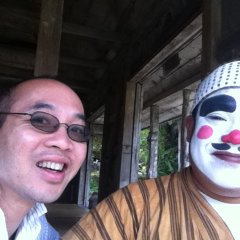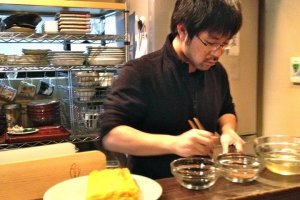Kaori would awake dreaming of sushi. Pink and succulent, her mother would shape miniature rice balls with translucent slices of sashimi in the palms of her hand. Today Kaori demystifies Japanese cuisine by deconstructing it to its basic elements, but her memories of cooking with her mother are never far away.
Many visitors to Kyoto find themselves in a parallel universe, seeing everything, yet nothing at the same time. A few hours at one of these top four cooking classes is a great way to experience how the locals live, allowing you to step inside a traditional machiya house and make some hands-on discoveries of Japanese culture and cuisine, one that's fun for beginners and experts alike.
Ryoujia Cooking Class - Western Kyoto (Nijo)
Kaori Bushimata is the embodiment of ometenashi, or the spirit of Japanese hospitality. From the detailed culture and history notes to the careful explanation of why each dish is prepared in a certain way, she takes us on a step-by-step journey into the world of Japanese cuisine that only an insider can take us, taking care that we don’t trip on the way or forget to see that we are part of the evolution of gastronomic culture. From the royal court a millennia ago to modern-day street food, I soon learned that sushi used to be street food in its heyday, not elevated to the gastronomic temples of today.
It is the little touches that make her classes so memorable. Today she went to the temple well to collect some spring water to make miso soup from scratch. As many sake makers can attest, the quality of water can make or break the final product, and this is true for delicate soups as well. She then cuts a bit of kelp and asks me to feel it, smell it and then taste and chew it. When I cooked the kelp in the spring water, I can taste the ocean. At the same time, it is not an overpowering taste, like a cross between broth and green tea. Dashi is the foundation of many Japanese dishes, which was why Kaori taught us how to make them.
Why should I go? Attention to detail provides a complete sensory experience. You can also stay in this machiya, allowing you to practice your skills afterward in the same kitchen.
Emi's Uzuki Cooking Class - Northeast Kyoto
It can be terribly hard to make Wagashi, a Japanese sweet that complements the bitterness of Matcha in a tea ceremony. At Emi’s cooking class, however, her home truths have made this art form attainable even for novices. At the same time, you can feel the reverence she has for her ingredients, carefully bathing and blanching her red adzuki beans to bring out their best in making zenzai. “Always keep the beans under water”, she says, treating them almost like her pet fish. As I massaged the ingredients in her calming country-style kitchen, I felt the peace and mindfulness that usually comes with meditation.
Why should I go? It's like cooking with your mother in a country kitchen. Classes are limited to a maximum of 4 people to ensure individual needs can be attended to. Her husband has a pottery showroom next door, allowing you to enjoy the pleasure of ceramics and cooking at the same time.
Taro's Haru Cooking School - Northeast Kyoto
Cooking with Taro Saeko, his wife Yoshiko and their young daughter Haruko is like experiencing a slice of Japanese family life twenty minutes from central Kyoto.
Taro San showcases farm gate to plate cooking and has a personal relationship with his farmers, and proudly showed me the certificate for his wagyu beef supplier. He loves his Kobe beef and tells me that in Japanese cuisine it is best cooked in its own fat as dairy products were not originally part of Japanese cooking. He also prefers to serve his Kobe beef medium rather than rare, because the marbling makes the meat even softer after it is slightly melted when the meat is cooked this way. His class also caters to vegetarian and non-beef eaters. Actually, throughout his class, he explains the secrets of eating healthy and is passionate about showcasing soybeans and seaweed in his recipes.
The highlight for me was the preparation of tofu by scratch from soya milk, which is easy to make. With a texture more likened to the finest cream cheese, Taro tells me that tofu is best eaten the day it is made, and I now know why.
Why should I go? His class is full of simple yet useful insights that allow you to easily replicate his recipes in your own home without specialist equipment or long hours in preparation. Given his previous life in the United States, he is comfortable connecting with people from different cultures, and soon you fall into his charm, relaxing and seeing how jovial everyone is in the class, chatting, laughing, and yes, cooking as well.
Cooking Sun Cookery School - Central Kyoto
Located about ten minutes from Shijo Station, Cooking Sun studio is housed in a beautifully restored townhouse. For three hours, you can immerse yourself in a typical Japanese kitchen and discover how to use local ingredients in a fun and user-friendly way.
You will be able to prepare dishes such as baked salmon, deep-fried vegetables, sukiyaki, and tempura. You'll usually be split into teams of two people and you can expect a lot of fun! Even beginners can enjoy this but you may sometimes face some challenges with your partner, which will make this experience even more enjoyable. Will you manage to roast this salmon without burning it?
Like the other classes, Akiho gives us expert tips for cooking in perfect English. Many things differ between Japanese and Western cuisine, and she won't hesitate to explain how it affects the preparation of food. For example, did you know that Japanese water was different from European water, which has more minerals, so it makes the rice cook differently?
Why should I go? A modern commercial kitchen combined with a slick operation makes it suitable for singles, couples, and groups of up to eight people. Learning here is fun and is a great way to make friends over a meal afterward.



































